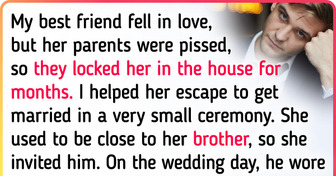15 Cases When People Wanted to Sink Through the Floor Because of Their Blunders

Every girl sees her perfect wedding in her own way. Some want their weddings to be quiet and peaceful, while others dream about big rooms filled with hundreds of guests. But everyone agrees that marriage should only happen when 2 people love each other. But in the past, it was possible that newlyweds only saw each other for the first time after the ceremony, bread was the main dessert, and brides didn’t carry flowers in their hands.
We at Bright Side have collected some wedding traditions of the past that might amaze modern newlyweds.
In the Middle Ages, you didn’t need witnesses to get married. To make a marriage, you just needed to say the vow. And it didn’t matter where it happened, so anyone could become a wife right in the middle of the street.
In the future, in order to be able to prove a marriage between common folk (which was abused by both men and women), people who registered the marriage were used.
Before the nineteenth century, women wore any of the newest and most attractive dresses they had, mostly with bright colors because white was not only impractical but was also believed to be a mourning color. This is why green (the symbol of youth) and blue (the symbol of purity) were the most popular colors.
The trend of white dresses appeared only 180 years ago after the newspapers published news about the marriage of Queen Victoria who chose a white satin dress for the ceremony.
In the Middle Ages, wedding bouquets were made of garlic and basil, and it was necessary. Brides used this mix to hide the smell of their unwashed bodies.
At wedding ceremonies, treats were given to guests. In Ancient Rome, wheat or barley bread was broken above the head of the bride. In the Middle Ages in England, people made buns that they put on top of the newlyweds that had to get married under them.
Sweet pies with something like frosting only appeared in the sixteenth century when sugar became more affordable.
Choosing the date of the wedding depended on different superstitions connected with the days of the week. The English folklore says that Wednesday is the best day for marriage, Monday is for richness, Tuesday for health, and Saturday is the worst day for marriage.
A dowry was an essential part of a wedding ceremony in many cultures for many centuries, and it’s still a tradition in some families and regions. The dowry was a gift for the family of the fiancée, and it was collected by the girl’s parents. The dowry could increase the attractiveness of the bride in the eyes of other people.
You’ve heard about the “something old, something new, something borrowed, and something blue” tradition. This tradition appeared in the Victorian era in a rhyme where these things were supposed to protect the bride from evil. Something blue was a garter, something borrowed was a thing from a woman that already had a child, something old was something inherited connected to the girl’s past, and something new was given to the bride by the family of the fiancé, symbolizing a new family.
There is still a superstition that says seeing a bride in a wedding dress before the wedding is bad luck. This superstition first appeared because the fiancé and the bride could only see each other after the vows and the wedding were organized by their parents.
In the past, people believed that the wedding should be organized and paid for by the family of the bride. They paid for the invitations, decorations, food, and drinks, as well as the clothes of the bride and whatever she wore after the wedding. The fiancé’s family paid for the bride’s bouquet, rings, the priest, a gift for the bride, and the honeymoon.
In the past, people believed that the veil made the bride look like a candle fire, and it scared evil spirits away.
Aside from that, many marriages were made for financial reasons, so the long veil and train were necessary for the brides that were going to get married to old men. They helped prevent the bride from running away because it was hard for them to move.
What wedding customs of the past do you know about?











